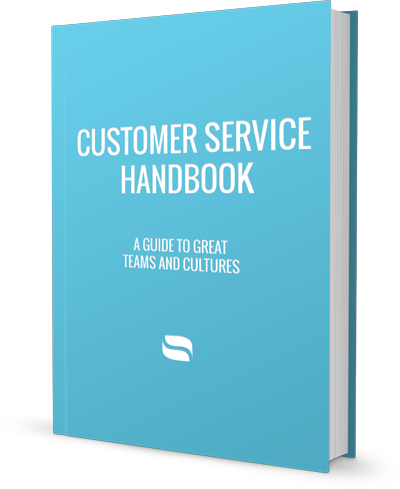







The Problem
This is a part of a continuing series that is also available as a downloadable eBook here. We talked to 35 companies, including Stripe, Twilio, and Mailgun, to get a sense of what it takes to run a great customer support organization. While every company is different, there were some trends that we could identify as benchmarks for great customer support.
The origins of customer support always seem to be organic. As soon as you bring a product to market, the need for customer support becomes an essential part of doing business. The inherent nature of this phenomenon means that you have a customer support operation no matter what type of business you are. Therefore, you either don't have a problem now, but will in the future. Or, you have a problem now but it hasn't manifested itself enough for you to notice.
Misgauging the pressure on your customer support team as your business scales is often the root cause for future headaches. When you're just starting out, it might be counter intuitive to see how your investments in customer support can be inversely proportional to how fast your business is growing. For example, the public beta period for a technology startup, where the user base is growing but product and revenue growth remains relatively flat for a short amount of time, is actually the most crucial time to focus on getting customer support right.
Depending on the type of business, the risk of developing chronic customer support problems originates from in between the two ends of this spectrum:
- Focusing too much on other areas of a business and neglecting the importance of customer support (questions, concerns, feedback, etc.)
- Focusing too much on customer support by over anticipating the growth of a business and weighing it down.
Before starting our company, we worked at other startups where failures to address the above forms of risk led to complications that were much harder to alleviate later on.
Startup A delivered an innovative point-of-sale e-commerce platform for merchants. Because e-commerce fluctuates seasonally, Startup A added new support processes and agents constantly in "preparation" for spikes in traffic and support volume. The original team, composed of two dedicated support agents, quickly grew to a team of more than 10 in less than half a year. The excessive emphasis on customer support, which should be given credit, resulted in the over-complication of tools, processes, and personalities which were unfit for a startup.
Startup B built online communities for buying and selling used goods. Startup B focused the majority of its time on delivering a better and more secure shopping experience. Investments into finding a suitable tool and building a process around supporting customers were marginal. Support staff relied on hacked together tools from bug trackers and project management apps. The website and product reflected this mentality by making it difficult for customers to contact support. This over emphasis on building the best product detracted the ability for startup B to adapt to the needs of its customers.
The answer to whether or not you have a problem with customer support cannot be simply a yes or a no. Start to think about your position as a balance between the two poles. Seeing and feeling the pull from either pole will help shape an approach to building a well-functioning customer support atmosphere.
Why Customer Support?
It's just too valuable to even measure. And fortunately, it's hard to measure the value of an efficient customer support team and culture. It touches on every aspect of running a business from marketing to product development and from engineering to business development and sales. Because customer support's range is minimalistic in function but so universal in application, it often plays the unsung hero. This characteristic is also the reason why customer support can oftentimes be over-valued or under-valued.
Taylor @ Mailgun
"I think it's crucially important to focus on support especially early on in a product's lifecycle: 1) it creates a feedback loop that helps guide product development and 2) good customer support is a very effective differentiator and word of mouth marketing tool."
One important caveat is of course the size of your business and the product/service you're delivering. While large companies may benefit from having a customer support team that is more dedicated to helping end-users and less connected to other business elements, smaller companies benefit immensely by having connected teams and a system where customer support becomes an external-facing extension of internal business processes.
Christie @ Outright
"We are the front door to what needs to be changed, fixed, and what customers are asking for. We're the wealth of knowledge that provides insight into the product and into customers' brains. Companies that don't view customer support this way are really at a loss."
Misconceptions And Stereotypes
To be honest, we don't like the way people cringe when they hear "customer support". Unfortunately, we can't blame them for their harsh criticisms when so many companies do it wrong. Just do a simple Google Images search for the term "customer support" and you'll see what we're talking about. Cartoons of sleazy call centers and stock photos of support agents smiling absurdly are common results that haunt.
These misconceptions come about because too many companies are trying too hard. They're trying too hard to look professional, sound professional, and feel professional. This sort of treatment is immediately noticeable because most "professionals" are a pain in the ass to deal with. These stereotypes come about because your staff is forced to become professionals when they're much better off just being themselves.
Llewellyn @ Oodle
"Overcoming stereotypes is definitely difficult. Sometimes thinking too hard about customer support can actually make it worse. I think amazing customers on a daily basis by getting back to them swiftly or replacing an autoresponder with a genuine email are great simple first steps. It shows that we truly respect their time."
The goal here isn't to shape a customer support team into a professional team but into a well functioning relationship-building team. If you want to build a "professional" customer service team then this is not the book for you. A "professional" support team means:
More rules
More constraints
More management
More tools
More no's
More scripts
More run-around
More delays
If fact, we'd argue that a customer support team with less professionalism, less constraints, less rules, and less metrics can outperform one with more of everything. This obviously doesn't mean your staff shouldn't present themselves well and remain polite. We'll cover more of this concept throughout the book.
To overcome misconceptions and break stereotypes, you must stop thinking about customer support as a professional services branch of your company and more as an integrated identity that you feel comfortable exposing to the public.
Fixating On Irrelevant Things
There is a barrage of irrelevant things that can bog you down when you're just starting out with building a customer support team. Keep in mind that you neither want to over invest by over valuing nor do you want to under invest by under valuing customer support.
- The right team size. Our rule of thumb is: one is fine, two is fun, and three is game.
- The right tools. No tool is the right tool in the beginning. Stick with email, something you're familiar with right off the bat and easily scalable.
- The right process. There is no better process than talking as much as possible with customers, teammates, and other teams.
- The best hours. Your customers' hours are your best hours. Do your best to get back to them as soon as possible and leave out your operating hours.
- Which canned responses? This goes into our philosophy on canned responses. There is no greater waste of time than to write out pre-packaged responses for anticipatory questions. You're trading relationships for speed and the tradeoff just doesn't make sense. Canned responses can be done right. Keep reading for the secret.
- The right budget. This goes into our philosophy on why customer support is not a cost center. Spend as much as you need to but only enough to generate positive traction with customers.
That Annoying Cost Center
It's easy to see why customer support can be a severe cost center even if you just take an abstracted view of a large company. The amount of staff and resources required to handle inbound volume makes measuring anything tangible murky.
Modeling the support team and culture you want to build after a large company right off the bat is almost certainly going to fail you. The cost center mentality originates from the need to scale up infinitely. An excessive support workforce, bloated tools, phone support, 24/7 support, international support, live chat, advanced ticketing, SLAs, security, and many more, can quickly add up for a small business. These things divert attention from what's really important and valuable in a support team. Thinking about customer support as a cost center is a mental state, not a fact.
The key is to avoid the cost center mentality by avoiding the large company model and embracing a leaner mentality. A great way to start out is to start small. At our previous startup we needed a way for engineers to support non-technical teammates with a variety of questions. We established a simple process for communicating, sharing, and cooperating using simple tools such as email.
When we launched our public beta we took that same internal support process and made it public facing. Refinements to the process were made with no additional investments into new staff or tools. By not sinking resources into customer support, we were able to clearly see the value it created. Think of it this way, because value derived from customer support runs on a longer realization cycle, the cost associated to maintaining a large investment adds tremendous pressure on a business. By keeping your initial team small, tools simple, and process clean, you can devote more time to focus on building relationships with your customers and actually helping them. This positive value generation is crucial to getting the early stages of your customer support team and culture off the ground.
Seeing The Connection
Helping your customers is helping yourself. When you set out to help your own teammates you are essentially building the cultural foundations for a great customer support team. When you realize that the two are essentially two sides to the same coin you'll understand how true value is generated from the relationships you're able to build and not the tools or the processes you choose to adopt.
Llewellyn @ Oodle
"Customer support is such an important selling point that more businesses should list it as a feature. Think about it, other than the product itself, customers actually count on us to help them through everything. Ideally, companies wouldn't even need to advertise great support since all support will be great. That's when we can truly break down stereotypes."
Chapters
How's your customer support?
We build brilliant customer support software for companies like yours.
Stop wrestling with ticket numbers and start delighting customers with Reamaze, our cloud helpdesk.
We wrote the book on Customer Support
Literally.
Our book includes interviews with some of the top customer support organizations in the industry and shows you what it takes to deliver consistent, high-level support, whether you're a one person startup or a Fortune 500 enterprise.

Get our eBook under "Official Downloads"
Join thousands of teams using Reamaze to impress customers.
Find out how with a free account.
